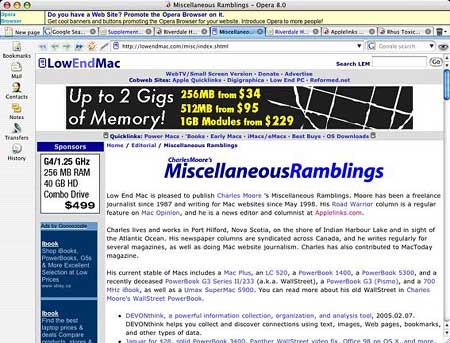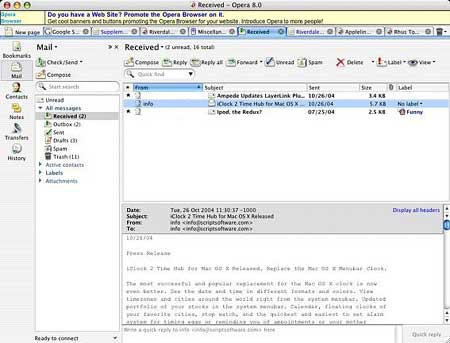Who'da
thunk it? For the past several weeks, Opera, specifically the Opera
8.0 Preview 1 for Mac, has become my browser of choice. It's still
got a few rough edges (this is an alpha build, after all), but its
combination of raw speed and several unique features make Opera 8
the browser I choose more often than not these days.
It's been a long journey, but Opera is finally delivering on the
Mac.
My first encounter with Opera was in the late 90s when the
PC-oriented ISP operator I was an agent for told me about this
"great new browser" - PC-only at that point. I checked it out using
a Virtual PC on a Mac and wasn't terribly impressed.
Nor did the early versions of Opera for the Mac entice me. The
interface was quirkily interesting - but not in a really satisfying
way - and the performance fell well short of Opera's "fastest
browser on the planet" hype. Bookmark implementation was clumsy and
frustrating, and the program crashed a lot.
The tide turned with the release of Opera 7 for the Mac. The
interface was cleaned up - still not "conventional," but quite
pleasant to use. The bookmarks were fixed. And it was a lot
faster.
Unfortunately, I found that it still crashed a lot. When each
new fractional update came out, and I would use it for a few days
and then get frustrated and go back to Firefox or Safari.
That has not happened with Opera 8. The speed is seductive. I
haven't done any timed comparisons, but my gut tells me that at
least on my dialup connection, Opera 8 is at least as fast as
- and possibly faster than - Firefox, Netscape, or Safari. Startup
speed has improved as well, although there is still room for
improvement in that department.
- Editor's note: See today's article, What's the Fastest Browser on the Mac?
Across Platforms?, to see how fast Opera 8.0 is compared to
other browsers.
Speaking of startup, one of the coolest features of Opera is the
startup option of restoring the set of windows or tabs that were
open at the end of your last browsing session. I find this even
more convenient for my purposes than OmniWeb's somewhat similar
"Workspaces" teacher, and it goes a long way toward mitigating
Opera's still worse than average incidence of unexpected quits.

Opera 8.0
Opera 8's user interface has been further streamlined, mostly to
the good, although I find that the progress readout is less
informative as that used to be.
There is more window workspace in the default setup, a cleaner
menu setup (including a neat new pulldown Start bar in the URL
field containing icons for Top 10 favorite links, Home, and
Bookmark), as well as Amazon and Price Comparison search fields,
and dynamic display of messaging features. This is all good
stuff.
Opera's '"Fit to window width" feature removes the horizontal
scrollbar and configures Web pages to fit to the width of browser
window, eliminating the annoyance of having to scroll horizontally.
The "Fit to page width" feature improves printing. For a full list
of changes and enhancements, see the appendix
to this article.
There are still some non-conventional quirks. For instance, you
press Command-N, which normally creates a new window on the Mac,
instead of Command-T to open a new tab.
Another area where Opera continues to swim against the current
is in adding an email client, Usenet newsreader, RSS newsreader,
IRC-compatible chat client, contact database, spelling checker, and
spam filtering. Mozilla.org has been moving away from the suite
application concept with its separate Firefox and Thunderbird
applications.
Personally, I've only experimented a bit with Opera's mail
module, but it seems to work fine, and the Opera browser/email
client application is smaller than Mozilla's email-only
Thunderbird.

Opera Email
The Opera mail module is accessed from the sidebar in the main
window, which also includes a History tab. A minor annoyance is
that I found that the history record is not 100% comprehensive -
some pages visited don't appearing for some reason.
Last week, Opera also released version 7.54u2, which is mainly a
security update fix.
If you haven't tried Opera yet or checked out an earlier version
and were underwhelmed with its performance, it's worth revisiting,
especially the Version 8 preview. Browser preference is to a large
degree a matter of taste, and you still may not find Opera to be
your cup of tea, but if you give it a chance, it can also become an
acquired taste.
Available for Mac OS X, Linux, FreeBSD, Solaris, and Windows, an
ad-sponsored version of Opera is free. The ad-free version costs
US$39.
System requirements: Mac OS X 10.1 or later.
Appendix
New in Version 8
At first glance
- Improved user interface
- More workspace in the default setup.
- Cleaner menu setup and dynamic display of messaging
features.
- Notification of blocked popups.
- Simple retrieval of closed pages and blocked popups.
- New start bar gives easy access to useful features.
- "Fit to window width" feature removes the horizontal
scrollbar.
- "Fit to page width" feature improves printing.
- Enhanced RSS news feed reader is available without activating
e-mail client.
- Support for XMLHttpRequest; Gmail Web mail is fully
supported.
Mac-specific changes
- Huge performance improvements.
- Improved stability.
- Added ability to check spelling in text areas and Opera Mail.
As it's based on the system spelling checker, no additional
programs are needed.
- Fixed daylight savings time offset problems in Opera Mail.
- Fixed problem where typed URL opened in a background page.
- Added ability to drag files into Opera Mail composition window
attachment list.
- Better support for dragging images in OS 10.2 and later.
- Made tool tips slightly transparent.
- Activated auto-proxy detection.
- Improved dynamic UI changes (i.e. menu bar changes).
- Printing page ranges should work now.
- Correctly set default values for the print settings.
- Fixed problem where some menu items stopped working after a
period of time.
- Mouse gestures will work again for users without two-button
mice.
User Interface
- Extensive simplification of menus and dialogs. The menu and
panel setup is now dynamic and depends on what features the user
has activated:
- The "Mail" and "Chat" menus and panels are added as e-mail and
chat accounts are set up by the user. Account handling is now
available in the "Tools" menu.
- A separate "Feeds" menu is added when the user adds an RSS news
feed for the first time.
- The contacts panel is only displayed if e-mail or chat accounts
exist.
- Removed "Navigation" menu.
- Added trash can button on the page bar that notifies of blocked
popups and doubles as a repository for closed pages that can be
retrieved.
- Unwanted popups are now blocked by default.
- Added start bar that drops down from the address field when it
is focused. Contains various options for navigation and
search.
- Added view bar toggled by the eye button on the address bar.
Contains new "fit to window width" feature, search in page, and
styling/zooming options.
- New customization dialog (View > Toolbars > Customize)
includes customization of panel setup.
- New "Delete private data" dialog has simple and advanced
options.
- "Continue from last time" is now the default startup
setting.
- In the default setup, each tab on the page bar has its own
"Close" button.
- Swapped F4 with Shift + F4 for toggling panels. F4 now toggles
the panels with the panel selector.
- Added Cmd + F12 and Shift + F12 as keyboard shortcuts for the
Preferences and Customize dialogs, respectively.
- Enabled text selection in certain dialogs, such as JavaScript
Alert.
- The "inline find" option for search in page has been moved to
the search preferences.
- Added setting for (dis-)allowing scripts to hide the address
bar. Available in Opera > Preferences > Multimedia >
JavaScript options.
- Fixed problem selecting the first letter of a text selection
with the mouse.
- Fixed problem where form element status was forgotten when
toggling print preview.
Display and standards support
- Implemented Opera's Extensible Rendering Architecture (ERA):
- Added "Fit to window width" feature. Available on Web pages and
for printing, this setting squeezes page contents to make them fit
the width of the screen and avoid horizontal scrolling or margin
overflow.
- The "Small screen" mode now includes more of the page's
original styling.
- Support for XMLHttpRequest, required for using Gmail Web mail.
Also added support for XMLSerializer and DOMParser.
- Support for DOM3 Load and Save.
- Transparent background (wmode) support for plug-ins.
- Changed calculated line height to be based on actual font size
rather than specified font size.
- Fixed handling of nested floats.
- Several fixes related to bidirectional text support.
- Allow mixing of background-position and keyword, in accordance
with CSS2.1.
- Borders on text fields can be removed with CSS.
- Improved handling of paged media.
- Recognize "application/vnd.wap.xhtml+xml" documents as
handheld.
Messaging and newsfeeds
- When a page has embedded links for one or several RSS
newsfeeds, an RSS icon is displayed within the address field. Click
on the icon to subscribe or get a multiple choice menu if several
news feed links are present. Improved "Add news feed?" dialog.
- Separate "Feeds" menu is added to Opera's main menu when first
news feed is activated. Newsfeeds can now be read independently of
the mail panel.
- Improved consistency of news feed checking.
- Added options to mark message threads as read (keyboard
shortcut M) and go to next unread thread (shortcut N.
- Several improvements to quick reply: expand automatically when
typing multiple lines, handle one draft per message, and reset
focus to message list after replying.
- Chat improvements:
- Status is now set globally in the chat menu.
- Added "ban" and "kick with reason" commands, as well as typed
"/invite" command.
- Support for links/URLs using "irc://".
- List of servers updated and expanded.
Security
- Fix for tabbed/MDI browsing vulnerability reported in Secunia
Advisory SA12713. For more information, see Opera's security
advisory: Phishing attack possible with a delayed JavaScript
prompt
- The closed padlock icon for secure sites now appears inside the
address field. Click to display security information concerning the
site.
Documentation
- Help documents are now on line, still accessible from the menu
or by pressing Cmd+?.
- Implemented inline error pages that replace most error
dialogs.
- Help files and error pages have the CSS signatures "opera-help"
and "opera-error".
Miscellaneous
- Manual "Check for new release" option added to help menu.
- Fixed authentication issue; pages can now be authenticated in
any sequence.
Fix to restore previous default file settings after uninstalling
Opera.




